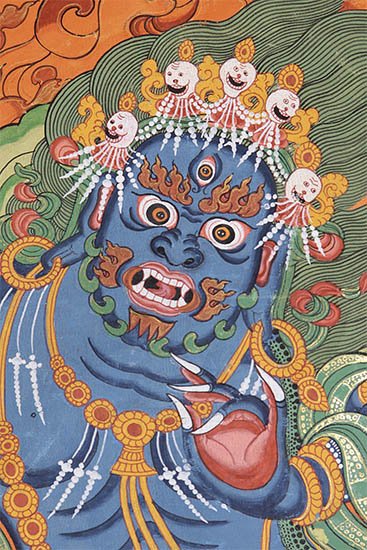Pancamunda, Pañcamuṇḍa, Pancan-munda: 1 definition
Introduction:
Pancamunda means something in Buddhism, Pali. If you want to know the exact meaning, history, etymology or English translation of this term then check out the descriptions on this page. Add your comment or reference to a book if you want to contribute to this summary article.
Alternative spellings of this word include Panchamunda.
In Buddhism
Tibetan Buddhism (Vajrayana or tantric Buddhism)
Source: MDPI Books: The Ocean of HeroesPañcamuṇḍa (पञ्चमुण्ड) refers to “five hairless heads”, according to the 10th-century Ḍākārṇava-tantra: one of the last Tibetan Tantric scriptures belonging to the Buddhist Saṃvara tradition consisting of 51 chapters.—Accordingly, “[...] [He should visualize Heruka] [...] The weaponry in the seventy-two hands is thus to be discerned in order. A decoration (headband) made of five hairless heads (pañcamuṇḍa-kṛtābharaṇa), an ornament of the six seals, a garland of a hundred hairless heads [as a necklace], sounding armlets and anklets, a garment [made of] some tiger skin, and a romāvalī (or line of bodily hair) are on [his] body. Before him is a great goddess [named] Vajravārāhī, [who is] as previously. [...]”.

Tibetan Buddhism includes schools such as Nyingma, Kadampa, Kagyu and Gelug. Their primary canon of literature is divided in two broad categories: The Kangyur, which consists of Buddha’s words, and the Tengyur, which includes commentaries from various sources. Esotericism and tantra techniques (vajrayāna) are collected indepently.
See also (Relevant definitions)
Relevant text
No search results for Pancamunda, Pañcan-muṇḍa, Pañcamuṇḍa, Pancan-munda, Panca-munda, Pañca-muṇḍa; (plurals include: Pancamundas, muṇḍas, Pañcamuṇḍas, mundas) in any book or story.